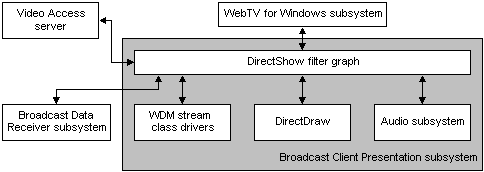
[This is preliminary documentation and subject to change.]
Broadcast clients can work with data streams from a wide range of video and audio devices. To do this, Broadcast Architecture works with Microsoft® DirectShow™, a component of the Microsoft® Windows® 98 operating system that lets applications control high-bandwidth data streams.
Broadcast Architecture components such as Microsoft® WebTV® for Windows use a DirectShow filter graph to control the presentation of audio and video data. The following illustration shows how the components of the Broadcast Client Presentation subsystem fit together.

The DirectShow filter graph is a Broadcast Architecture component that tells DirectShow what filters to use for Broadcast Architecture and how these filters connect to each other. The filters for Broadcast Architecture represent Windows Driver Model (WDM) stream class drivers for audio and video devices. Each filter has pins that represent inputs, outputs, and controls for the driver. The filter graph shows how these pins connect to other filters' pins and to applications that use the drivers.
The Microsoft® DirectDraw® application programming interface (API) is provided through a dynamic-link library (DLL) in Windows 98. Broadcast clients use a new feature of DirectDraw called Video Port Extensions (VPE). VPE provides an application programming interface (API) that accelerates graphics by providing direct access to bitmaps in off-screen display memory, as well as extremely fast access to hardware.
The audio subsystem is a component of Windows 98 that provides an API for applications to play audio.
WDM stream class drivers are components of Windows 98 used to handle high-bandwidth data streams. Filters in the DirectShow filter graph let applications control these drivers.
An important feature of the filters that control stream drivers is that they can be connected directly to each other to reduce the overhead of handling the stream data. For example, an audio stream driver for a satellite receiver can be connected directly to an audio stream driver for a sound card. This direct connection enables the audio to play without requiring an application to copy data from one device to another.